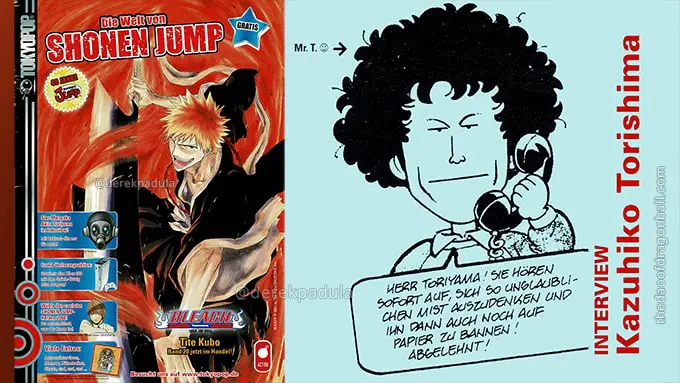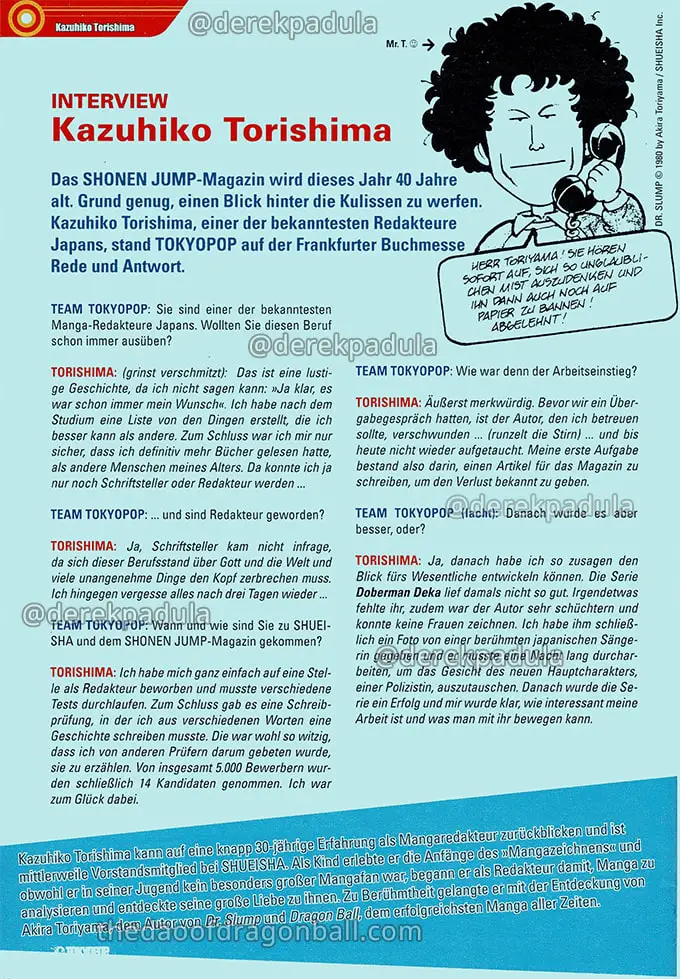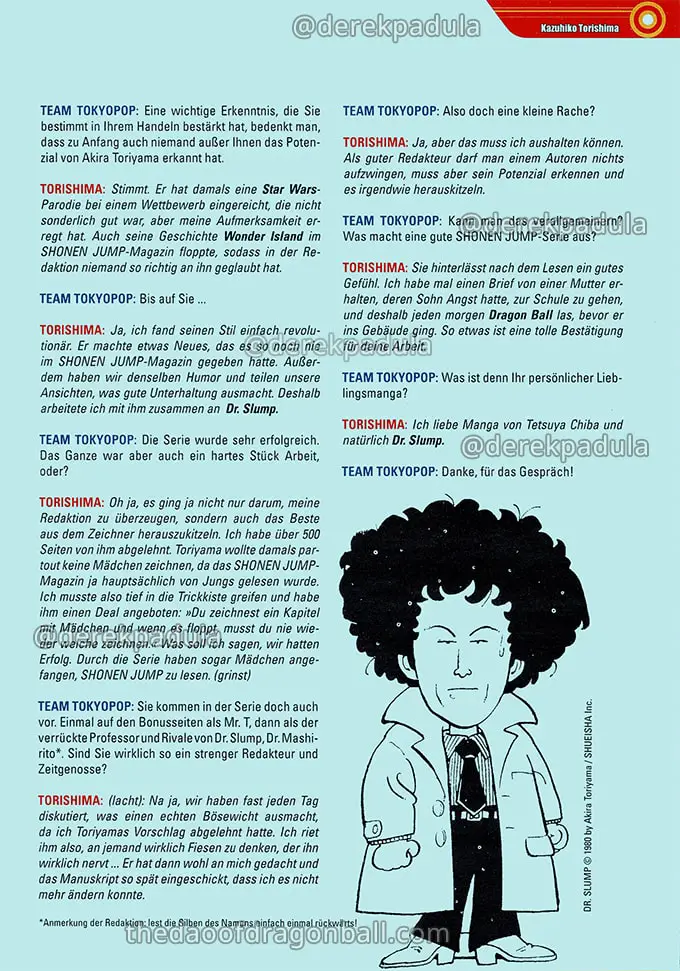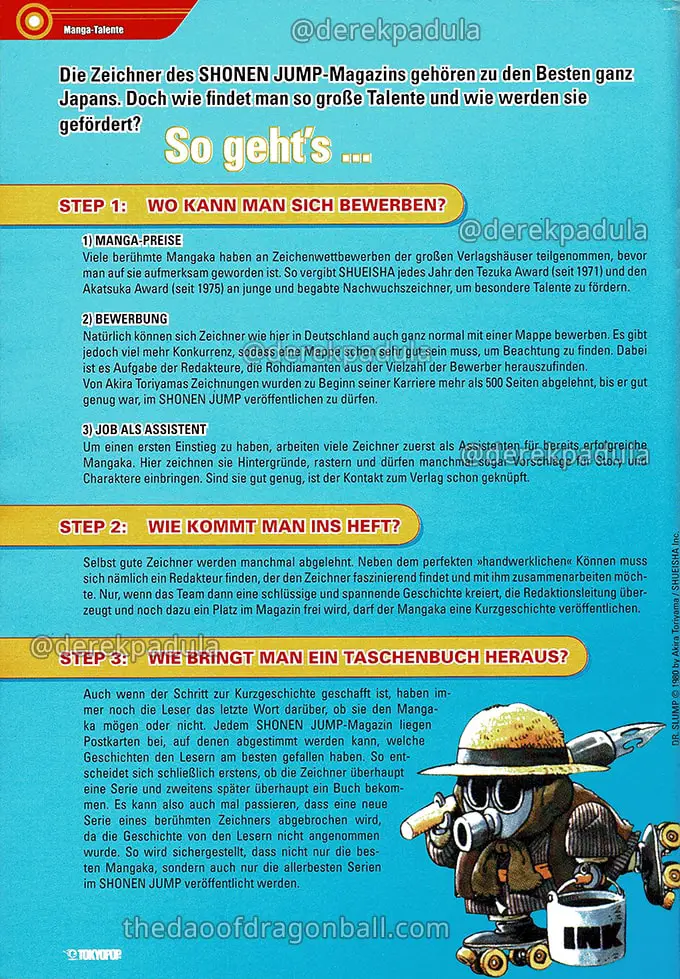Kazuhiko Torishima’s Lost Interview with Tokyopop Germany!

Read a long-lost interview with Akira Toriyama’s editor, Kazuhiko Torishima, published in Tokyopop Germany’s magazine in 2008!
This is the second part of Tokyopop’s interview series, following their interview with Akira Toriyama.
Both interviews were held at the 2007 Frankfurt Book Fair. They were then published in the first half of 2008 in a free promotional magazine for German readers.
Notes:
There is no record of Kazuhiko Torishima’s original Japanese words. I translated everything from German into English.
The translation is up front, followed by a bonus page in the magazine about how to become a manga-ka at Weekly Shōnen Jump, and then my explanatory footnotes.
Everything that follows here is a direct quote until the end of the interview, except for descriptive labels.
Interview with Kazuhiko Torishima Page 1

Shōnen Jump magazine turns 40 years old this year. Reason enough to take a look behind the scenes. Kazuhiko Torishima, one of Japan’s most famous editors, answered Tokyopop’s questions at the Frankfurt Book Fair.
Comic Speech Bubble: “Toriyama-san, you must immediately stop thinking of this ridiculous crap and then putting it on paper! Rejected!”[1]
The Editor’s Note is pointing to his hair: “Mr. T 😐 ->”[2]
Team TOKYOPOP: You are one of the most famous manga editors in Japan. Have you always wanted to do this job?[3]
Torishima: (grins mischievously): That’s a funny story, because I can’t say: “Yes, of course, it was always my wish.” After graduating, I made a list of the things I can do better than others. In the end, I was only certain that I had definitely read more books than other people my age. Then I could only become a writer or editor…
Team TOKYOPOP: … and you became an editor?
Torishima: Yes, writing was out of the question because in that profession you have to worry about God, and the world, and a lot of unpleasant things. I, on the other hand, forget everything after three days…[4]
Team TOKYOPOP: When and how did you get involved with Shueisha and Shōnen Jump magazine?
Torishima: I simply applied for a position as an editor and had to go through various tests. At the end there was a writing test in which I had to write a story using different words. It was apparently so funny that other examiners asked me to retell it to them.[5] From a total of 5,000 applicants, 14 candidates were ultimately accepted. Luckily, I was among them.
Team TOKYOPOP: How was the work at the start?
Torishima: Extremely strange. Before we had a handover meeting [from the existing editor to me], the author I was supposed to look after disappeared… (furrows his brow)… and he hasn’t reappeared to this day. So, my first task was to write an article for the magazine to announce this loss.
Team TOKYOPOP (laughs): After that it went better, right?
Torishima: Yes, after that I was able to develop an eye for the essentials. The Doberman Deka series didn’t do so well back then.[6] Something was missing, and the author was shy and couldn’t draw women. I finally gave him a photo of a famous Japanese singer and he had to work all night to change the face of the new main character, a policewoman. After that, the series was a success and I realized how interesting my work is and what can be achieved with it.
Bottom of page 1 caption: Kazuhiko Torishima can look back on almost 30 years of experience as a manga editor, and is now a board member at Shūeisha. As a child he experienced the beginnings of “manga drawing”, and although he was not a particularly big manga fan in his youth, he began analyzing manga as an editor and discovered his great love for them. He became famous for discovering Akira Toriyama, the author of Dr. Slump and Dragon Ball, the most successful manga of all time.[7]
Page 2

Team TOKYOPOP: An important insight that has certainly encouraged you in your actions, considering that initially no one but you recognized Akira Toriyama’s potential.
Torishima: Right. Back then he had submitted a Star Wars parody to a contest that wasn’t particularly good, but it caught my attention. His story, Wonder Island, in Shōnen Jump magazine also flopped, so no one in the editorial team really believed in him.[8]
Team TOKYOPOP: Except for you…
Torishima: Yes, I found his style simply revolutionary. He did something new that had never been done before in Shōnen Jump magazine.[9] We also have the same sense of humor and share our views on what makes for good entertainment. For this reason, I worked with him on Dr. Slump.
Team TOKYOPOP: The series was very successful. But the whole thing was a lot of hard work, wasn’t it?
Torishima: Oh yes, it wasn’t just about convincing my editors, but also about getting the best out of the artist. I rejected over 500 pages of his. Back then, Toriyama definitely didn’t want to draw girls, since Shōnen Jump was mainly read by boys. So, I had to dig deep into my bag of tricks and offered him a deal. “You draw a chapter with a girl, and if it flops, then you never have to draw any again.” What can I say, we were successful. Because of this series, even girls started reading Shōnen Jump. (grins)[10]
Team TOKYOPOP: You also appear in the series. Once on the bonus pages as Mr. T, then as the crazy professor and rival of Dr. Slump, Dr. Mashirito*.[11] Are you really such a strict editor and contemporary?
Torishima (laughs): Well, almost every day we had discussed what makes a true villain, since I rejected Toriyama’s initial suggestions, so I advised him to think of someone really mean and who really annoys him… He then probably thought of me and sent the manuscript in so late that I couldn’t change it.[12]
Team TOKYOPOP: So, a little revenge after all?
Torishima: Yes, but I have to be able to endure that. As a good editor, you can’t force anything on an author, but instead you have to recognize their potential and somehow tease it out.
Team TOKYOPOP: Can you generalize, what makes for a good Shōnen Jump series?
Torishima: It leaves you with a good feeling after reading it. I once received a letter from a mother whose son was afraid to go to school, so he read Dragon Ball every morning before he went into the building. Something like that is a great validation of your work.[13]
Team TOKYOPOP: What is your personal favorite manga?
Torishima: I love manga by Tetsuya Chiba, and of course Dr. Slump.[14]
Team TOKYOPOP: Thank you for the interview!
How to Become a Manga-ka

Here is an additional page in the magazine that explored the process of becoming a manga-ka in Weekly Shōnen Jump.
It features Akira Toriyama’s self-illustration from Dr. Slump, of himself wearing a straw hat, holding his famous ink pen, and riding on roller skates.
I’ve translated this section with the goal of showing how exceptional Toriyama was, even among those who were already considered exceptional.
Heading: SHONEN JUMP magazine’s illustrators are among the best in Japan. But how do they find such great talent, and how are they supported?
This is how it’s done…
STEP 1: Where can you apply?
- Manga Prizes
Many famous manga-ka took part in drawing competitions run by major publishing houses before they became famous. Every year, Shūeisha awards the Tezuka Award (since 1971) [Ed. for story manga], and the Akatsuka Award (since 1975) [Ed. for comedy manga] to young and talented up-and-coming illustrators in order to encourage the next generation.
- Application
Of course, just like here in Germany, illustrators can also apply normally with an art portfolio. However, there is a lot more competition in Japan, so a portfolio has to be very good to be noticed. It is the editor’s job to find the diamonds in the rough among the large number of applicants. [After Kazuhiko Torishima discovered Akira Toriyama], more than 500 pages of Akira Toriyama’s drawings were rejected early in his career until he was good enough to be published in Shōnen Jump.
- Work as an Assistant
To get started, many artists first work as assistants to already successful manga-ka. Here they draw backgrounds, ink images, and are sometimes even allowed to make suggestions for the story and characters. If they perform well, then contact with the publisher is made and their careers advance.[15]
STEP 2: How do you get into the magazine?
Even good artists are sometimes rejected. In addition to having perfect illustration skills, you have to find an editor who finds the manga-ka fascinating and wants to work with them.
[Once the relationship has been established], the manga-ka is allowed to publish a single-chapter story if the team creates a coherent and exciting narrative, convinces the editorial management [to take the risk], and a slot in the magazine becomes available.
STEP 3: How do you publish a physical volume?
Even if the above steps to publish a single-chapter story have been made, the readers will have the final say on whether they like it or not and want to read more.
Every Shōnen Jump magazine comes with a postcard, on which you can vote on which stories you liked the best. This is what determines if a potential manga-ka will continue writing their series, and if they’ll one day publish a volume of their work.
So, it can sometimes happen that a new story by a famous illustrator is cancelled, because the story was not accepted by the readers.
This ensures that only the best manga-ka will continue [working in the industry], and only the very best series will be published in Shōnen Jump.
Conclusion of Tokyopop’s Interview Series
How do you feel about Kazuhiko Torishima’s interview, alongside Akira Toriyama’s?
I’m glad that Tokyopop chose to interview them and we gained some insight into their early years and what makes for a successful series.
Thanks again to the German fan who shared this lost interview series with me, and to you for reading them.
If you’re a Dragon Ball fan who has something rare and wants to share it with others, please contact me!
And remember to share this article and buy my books so that I can keep doing the work of a Dragon Ball Scholar!
Footnotes
[1] Akira Toriyama often lamented his editor’s strict nature. Kazuhiko Torishima would criticize Toriyama’s ideas to the point where Toriyama would illustrate him saying the word “Rejected!” again and again.
[2] As a young man, Kazuhiko Torishima had large curly hair. Toriyama would often draw his editor into his work, and he was easy to distinguish from everyone else by his hair. The editor’s note points to his hair and reads “Mr. T”, as in ‘Torishima-san.’
[3] Kazuhiko Torishima is still one of the most famous manga editors in Japan, if not the most. He discovered Akira Toriyama and developed his talents, which led to the Golden Age of Weekly Shōnen Jump. He retired from Shūeisha in August, 2015 and became the President of Hakusensha in November. In 2018, he was promoted to the Representative Director (CEO + President).
[4] Torishima-san joined Shūeisha hoping that he would get assigned to Playboy for their ‘sophisticated articles,’ but instead was assigned to Shōnen Jump. The rest is history.
[5] Torishima-san has shared this story in other interviews, where he said that his wordplay surrounding the word “jeans” and “genes” was so comedic that he impressed Shūeisha’s editors and was offered the job.
[6] Doberman Deka (ドーベルマン刑事, 1975) is a manga series about a hardboiled detective. It was written by Buronson, who also wrote the famous Fist of the North Star (北斗の拳, 1983).
[7] I argue that Dragon Ball is still the most successful manga of all time, even though its sales have been eclipsed by One Piece. It’s still in second place in raw sales, at 260 million volumes, and its cultural influence on the world is beyond compare to anything else in the shōnen manga world.
[8] Akira Toriyama is famous for failing with his debut manga and scoring “dead last” in the weekly reader rating. But Torishima-san continued to believe in him, and Toriyama quickly developed his technique and went on to become the most influential manga-ka of the 1980s, ‘90s, and beyond.
[9] Torishima-san has said elsewhere that what caught his eye about Toriyama’s artwork was his use of English sound effects and lettering mixed in with native Japanese scripts.
[10] Dr. Slump is a series about a robot girl named Arale and her genius inventor Dr. Senbei. There are many stories from young Japanese readers who related to Arale, and in particular to how she was nearsighted and wore glasses (in spite of being a robot). Because of Dr. Slump’s nationwide success, they felt inspired by Arale, and no longer felt ashamed to wear glasses in school.
[11] *Editor’s note: Just read the syllables of his name backwards! [Ed. This footnote is found in the original]. It refers to how Toriyama took the syllables of To-ri-shi-ma and reversed them into Ma-shi-ri-to, to name the evil doctor in Dr. Slump.
[12] Toriyama’s annoyance with Torishima-san’s strictness is also what led to him being the model for the Great Demon King Piccolo in Dragon Ball.
[13] Here, Torishima-san acknowledges that Dragon Ball has a positive influence on others, such as the young boy who received courage from reading it. Years later he would say, “There is nothing to learn from Dragon Ball.” An argument which my life’s work proves is false.
[14] Tetsuya Chiba is a famous manga-ka of works such as the boxing manga, Ashita no Jō (あしたのジョー, 1968).
[15] Akira Toriyama never worked as an assistant. He went straight from high school to a graphic design job, and then to being a manga-ka. He also only had two assistants during his career, with one of them working for two years, and another for the following 13, independently of each other. This is abnormal for a manga-ka of a major series, who often has a handful of assistants.
' . $comment->comment_content . '
'; } } else { echo 'No comments found.'; }